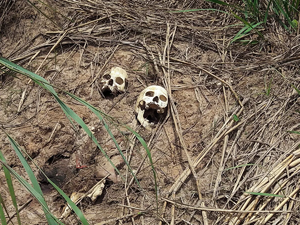Chélak Massacre: Difference between revisions
No edit summary |
|||
| Line 29: | Line 29: | ||
| units2 = 22nd Colonial Marine Infantry Regiment | | units2 = 22nd Colonial Marine Infantry Regiment | ||
| units3 = | | units3 = | ||
| strength1 = ~ | | strength1 = ~1,100 militia<br>3 {{wpl|Hotchkiss Mle 1914 machine gun|Hotchkiss machine guns}}<br>10 roadside bombs | ||
| strength2 = ~1,500 marines | | strength2 = ~1,500 marines | ||
| strength3 = | | strength3 = | ||
Revision as of 05:57, 23 March 2022
| Chélak Massacre | |||||||
|---|---|---|---|---|---|---|---|
| Part of First Pan-Septentrion War and The Struggle | |||||||
 Two marine bodies uncovered, 2015 | |||||||
| |||||||
| Belligerents | |||||||
|
|
| ||||||
| Commanders and leaders | |||||||
| Jean Yves Jerome | Jean-Luc Mignard † | ||||||
| Units involved | |||||||
|
9th Battalion 10th Battalion Local militia | 22nd Colonial Marine Infantry Regiment | ||||||
| Strength | |||||||
|
~1,100 militia 3 Hotchkiss machine guns 10 roadside bombs | ~1,500 marines | ||||||
| Casualties and losses | |||||||
| ~50 total | Entire force killed | ||||||
The Chélak Massacre was an ambush and then massacre of an entire regiment of Sieuxerrian Colonial Marines. The marines were marching from Chélak to Bibré and were ambushed with a mixture of effective machine gun fire and roadside bombs. Later survivors were assaulted by waves of Husseinarti militia armed with machetes, all survivors of the attack were later killed. The massacre was described as a "disgusting war crime" by then-Emperor Napoléon V, with later Husseinartian President Théodore Boulet Sawadogo describing it as a "righteous showing of Husseinartian resolve".
Background
For the past few months since the start of Sieuxerrian-involvement in the First Pan-Septentrion War, the colonial government in Husseinarti was attempting to quell the various riots that had sprung up as a result of the sudden lack of colonial troops, then the later implementation of conscription of the natives to fight in Casaterra. For the whole time since, the indigenous Husseinarti People’s Council had been locked in intense negotiations with the colonial government. The HPC wanted to avoid outright military conflict and instead force the colonial government to cede control to them as peacefully as possible, as it was perceived by the HPC that a peaceful ceding of power would give them an air of legitimacy on the international stage.
However the negotiations had gone almost nowhere since they had started, this is typically owed to the belligerent nature of colonial governor Lambert Girard. Governor Girard was noted by both Sieuxerrian and Husseinartians as an incredibly difficult person during these talks, typically resorting to tirads of racial slurs and general insults to the Husseinartian delegates. Following a relatively volatile exchange on 30 September, in which the governor had thrown porcelain tea cups at the Husseinartians, the delegates left and immediately began to plan a military operation to show the governor the resolve of the HPC.
At this time, the 22nd Colonial Marine Infantry Regiment had been preparing to move from Chélak to Bibré, where an understrength battalion-sized force of colonial marines and police had requested further support to help deal with rising tensions and riots in the city. Information from native scouts had been leaked to the HPC about the move and it was decided to act on this information. Jean Yves Jerome, a college-educated Husseinartian, had been selected by the HPC to lead the operation. While Jean lacked a proper military background, he was well-red in military campaigns and when selected for the mission he immediately began to amass equipment and weapons and prepare modified 75mm artillery shells into bombs. He also was given three Hotchkiss machine guns, which were all the machine guns the HPC’s Emergency Army had at the time. As well, his force lacked sufficient rifles and ammo, instead he instructed his men that “The Sieuxerrians have very kindly brought us the rifles we need, we simply need to take them”.
He was given command of two battalions, the 9th and the 10th, as well as some 300 local militia who rallied to aid him. Of his forces, only the 400-man strong 9th Battalion was equipped with mostly rifles, but lacked ammo for a prolonged fight. Identifying the usefulness of the machineguns ahead of the rifles, he ordered the men to give up most of whatever ammo they had to the machine guns. At most the riflemen of 9th Battalion had five cartridges to themselves.